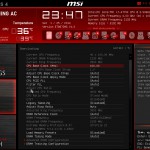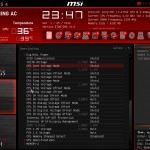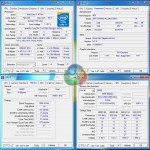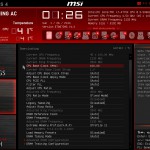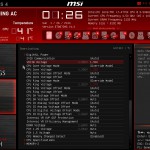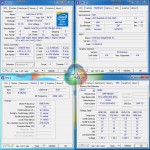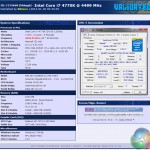Automatic CPU Overclocking:
MSI's OC Genie 4 automatic overclocking tool is identical to the implementation found on the Z87-G43 Gaming, hence our analysis starts to sound a lot like repetition.
The automatic overclocking tool can only be configured via the UEFI BIOS, not via an onboard button that MSI typically implements on its higher-priced motherboards. Thinking about the situation logically, it is highly unlikely that a user will feel compelled to enter their SFF system to press the OC Genie button; the BIOS-activated option is far more convenient.
The OC Genie 4 setting applied a 4.00GHz CPU frequency to our 4770K and opted for a 1.100V VCore. Other settings remaining untouched.
Our memory operated at its rated frequency of 2133MHz, but OC Genie 4 had automatically applied the secondary XMP profile which used a 50mV higher DRAM voltage. This didn’t present an issue for us, but it may for users of memory kits with XMP profiles of different frequencies.
This is actually a fairly well-tuned setting for the 4770K as it provides a small clock speed boost, but does so with a reduction in the VCore level. While this is a thoughtful feature on MSI's ATX and mATX motherboards, it becomes a particularly relevant parameter on a Mini-ITX board to which thermal concerns are ever present.
Unlike some of MSI’s other OC Genie 4-equipped motherboards (the Z87M Gaming, for example), the Z87I Gaming AC features a single automatic overclocking profile, not two. Given the SFF target audience, excluding the secondary profile may have a positive impact on the lifespan of MSI's Mini-ITX motherboard; a higher-voltage 4.2GHz overclock would serve as a challenge for the heat dissipation potential of many low profile CPU coolers.
The automatic overclock validation can be found here.
Manual CPU Overclocking:
To test the MSI Z87I Gaming AC motherboard’s CPU overclocking potential, we first increased the CPU VCore to 1.325V, Cache voltage to 1.275V, and CPU Input Voltage to 1.900V. These settings represent levels which will near the thermal limits of a system housed in a Mini-ITX enclosure, with a low profile CPU cooler.
Accustoming to the UEFI interface is the most challenging part of overclocking MSI's Click BIOS 4-equipped motherboard. Having spent a sizable chunk of time in the interface over the last few months, I can safely say that its functionality and ease-of-use do become far easier to deal with. As with most things in life; practice makes perfect.
We altered three voltage settings to provide extra stability and boosted our 4770K’s clock speed to 4.50GHz without hassle.
Although readouts in the BIOS showed that some voltage levels were higher than our desired settings, MSI’s Z87I Gaming AC was happy to deliver our input levels in an OS environment. We didn’t need to fuss about with load-line calibration or offset voltages.
The ease of overclocking with the Z87I Gaming AC motherboard is aided by Haswell’s simplicity, and a stable BIOS implementation on MSI’s part.
Providing 1.324V after we dialed in 1.325V proves that MSI's Z87I Gaming AC and accompanying Click BIOS 4 UEFI implementation provide excellent CPU VCore accuracy.
We pushed for stability at 4.6GHz, but as has been the case for every other Z87 motherboard that we have tested with our 4770K, a BSOD would quickly ruin our attempts.
Our 4.5GHz validation can be viewed here.
 KitGuru KitGuru.net – Tech News | Hardware News | Hardware Reviews | IOS | Mobile | Gaming | Graphics Cards
KitGuru KitGuru.net – Tech News | Hardware News | Hardware Reviews | IOS | Mobile | Gaming | Graphics Cards


